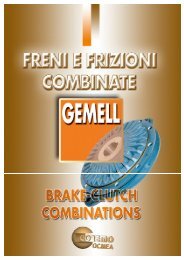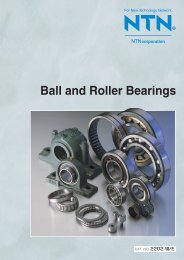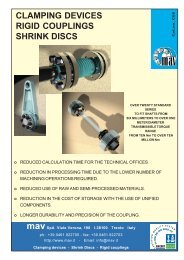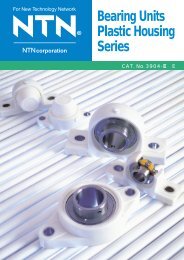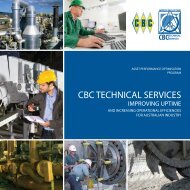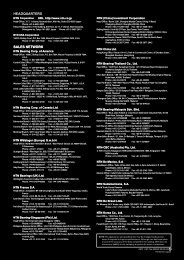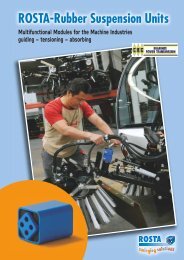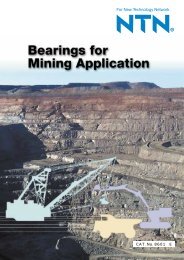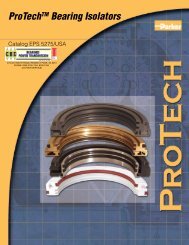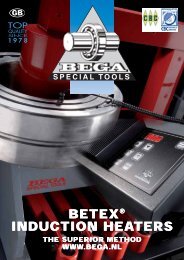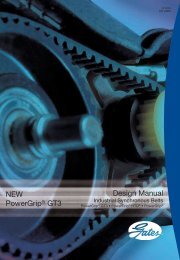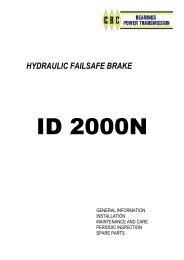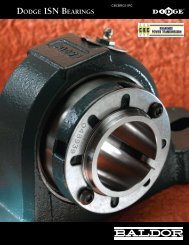Needle Roller Bearings - Ntn-snr.com
Needle Roller Bearings - Ntn-snr.com
Needle Roller Bearings - Ntn-snr.com
You also want an ePaper? Increase the reach of your titles
YUMPU automatically turns print PDFs into web optimized ePapers that Google loves.
Load Rating and Life<br />
NTN<br />
2.10 Radial internal clearance, surface<br />
roughness and surface hardness, and<br />
bearing life<br />
The relationship of radial internal clearance to bearing<br />
life is as shown in Fig. 2.9 and the relationship of surface<br />
roughness to bearing life as shown in Fig.2.10.<br />
It is possible to see from these Figures how the bearing<br />
life is influenced by each factor.<br />
1.0<br />
"Basic static load rating" is defined as such a constant<br />
static load that results in permanent deformation of the<br />
said limit value, which is then expressed in net radial load<br />
for radial bearings and in net axial load for thrust<br />
bearings.<br />
Regarding this load value, each table of bearing<br />
dimensions describes it in the Cor, field for radial bearings<br />
and in Coa field for thrust bearings respectively.<br />
When the load defined above acts on a bearing,<br />
contact stress at the contact center of rolling element to<br />
raceway, which are subjected to maximum load, reaches<br />
the following value.<br />
For roller bearing ⋯⋯⋯4000MPa (408kgf/mm 2 )<br />
For ball bearing ⋯⋯⋯4200MPa (428kgf/mm 2 )<br />
Fig. 2.9 Relationship of radial internal clearance to bearing life<br />
L10 life10 4<br />
Life ratioLL<br />
3000<br />
2000<br />
1000<br />
0<br />
0 0 20 40<br />
(1.0)<br />
1.0<br />
0.25<br />
Radial internal clearance10 -3<br />
(0.85)<br />
2.0<br />
0.5<br />
(0.37)<br />
(0.18)<br />
3.0<br />
0.75<br />
4.0<br />
1.0<br />
5.0<br />
1.25<br />
(0.09)<br />
6.0<br />
1.5<br />
The sum of surface roughnesses of test specimens in relative<br />
position before testing R max m ( ) showing Ra<br />
2.12 Allowable static bearing load<br />
The basic static load rating prescribed in Subsection<br />
2.11 is generally deemed as an allowable static bearing<br />
limit load, but in some cases this allowable limit load is<br />
set up larger than the basic static load rating and in some<br />
other cases it is set up smaller, according to the<br />
requirements for revolving smoothness and friction.<br />
Generally this allowable limit load is decided<br />
considering the safety factor So in the following formula<br />
(2.14) and Table 2.5.<br />
So CoPo(2.14)<br />
where,<br />
So : Safety factor<br />
Co : Basic static rated load, N (kgf)<br />
(For radial bearings: Cor,<br />
For thrust bearings: Coa)<br />
Po max : Maximum static bearing load, N (kgf)<br />
(For radial bearings: Por max,<br />
For thrust bearings: Coa max)<br />
Table 2.5 Lower limit value of safety factor S0<br />
Operating conditions<br />
Requirement for high revolving accuracy<br />
<strong>Roller</strong><br />
bearings<br />
3<br />
Ball<br />
bearings<br />
2<br />
Fig. 2.10 Relationship of surface roughness to bearing life<br />
Requirement for ordinal revolving<br />
accuracy (ordinary-purposed)<br />
1.5<br />
1<br />
2.11 Basic static load rating<br />
Load acting on a bearing, when acted, results in locally<br />
permanent deformation of the contract surface of rolling<br />
elements to bearing ring. And this deformation value<br />
increases inevitably with the increasing load and smooth<br />
rotation of the bearing is interfered with by the<br />
deformation when it exceeded a certain limit value.<br />
It is known experimentally that the total permanent<br />
deformation value 0.0001 times as large as the rolling<br />
element diameter at the contact center of rolling elements<br />
to raceway both of which are subjected to maximum<br />
stress is an allowable deformation limit which does not<br />
interfere with smooth rotation of bearing.<br />
Where minor deterioration of revolving<br />
accuracy is allowed<br />
(Ex. Low speed revolution, duty load<br />
application, etc.)<br />
Remarks: 1. For the drawn-cup needle roller bearings, 3 shall be adopted<br />
as So lower limit value.<br />
2. Where vibration and shock load act on bearing, Po max shall<br />
be determined considering the shock load factor.<br />
1<br />
0.5<br />
A-19




